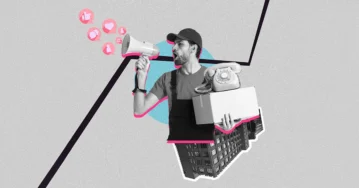Are you seeing little to no engagement on your stunning visuals, or are you wondering why your followers don’t convert into your real clients?
You’re not alone. Many creative studios face similar challenges, and that’s exactly why having a strong social media strategy for design agencies becomes important.
Because let’s face it. You can be as candid and creative as you want, but if your content isn’t reaching the right audience or driving the right kind of engagement, it’s not generating leads.
And without leads, your social media presence is just noise.
What your agency needs is a well-defined, data-backed framework that helps you plan better, post smarter, prevent mishaps, and turn scrolls into serious business results.
Let’s start.
In a world where over 2 billion people actively scroll through social media, your design agency’s success hinges on more than just visual appeal. A well-thought-out social media strategy is one that brings together data, aesthetics, and intent.
Let’s now dive into the step-by-step social media marketing strategy, so that all your posts strut with a purpose.
1. Understanding Your Agency Algorithm
The foundation of a digital marketing strategy is built on social media algorithms. They are like the ever-changing gatekeepers of social media success that may sometimes sabotage your reach.
But that’s not what algorithms are for (even though that’s how it sometimes feels). In fact, they’re simply designed to serve users more of what they like.
Design agencies often focus on creating highly visual content, but algorithms don’t just reward beauty – they reward behavioral signals like engagement, consistency, authenticity, and relevance.
So, the more your content is saved, shared, commented on, or watched till the end, the more the algorithm sees it as relevant.
Here’s what matters most for design agencies:
- Consistency: Infrequent posting hurts reach. Algorithms prefer steady, active accounts.
- Engagement: Posts that trigger meaningful interactions (comments, shares, saves) get prioritized.
- Content quality: Dwell time, completion rates (for videos), and saves are stronger indicators than likes.
- Relevance: The algorithm tracks how aligned your content is with what your audience usually engages with.
As a design agency, you must focus on creating more save-worthy content – showcase your best designs, provide design tips, process breakdowns, etc, anything that would offer value to your audience and make them save your posts for future reference.
The Instagram Explore tab also prioritizes posts with high save rates, alongside other signals like likes, comments, and user behavior.
The “save” option on social platforms often signals long-term value. The algorithm picks up on that and rewards your content with wider reach.
2. Setting Your Goals Straight
Let’s now talk about setting your business goals. After all, we must know what we are aiming for. That being said, “staying active” is not one of them. Because let’s be honest- this may sound good, but in reality, it won’t even move a needle.
As a design agency, your social media goals must revolve around solving real client problems. Start by thinking like a client: What do they expect out of you? That is the outcome your content must deliver.
Goals you must set:
- Lead Generation: How many monthly leads or qualified inquiries do you need to get from Instagram or LinkedIn?
- Portfolio Engagement: Beyond likes, keep a watch for saves, shares, profile visits, and portfolio link clicks. These reflect a serious interest.
- Brand Voice and Authority: Set goals for thought-leadership content performance, like the number of LinkedIn carousel shares or comments that spark design conversations.
- Client Trust Metrics: Track conversion of social inquiries into paid work and monitor repeat clients referred via social channels.
Your ultimate aim must be to increase your brand awareness, generate leads, and boost community engagement.
Focus on creating strategies that generate more profile visits and post some thought leadership pieces that earn you more quality comments and work enquiries.
Just like design iterations, revisit your goals every quarter. Use benchmarks – like a 25% increase in saves or double-digit lead growth – to tweak your strategy and stay ahead of platform shifts.
3. Understanding Your Target Audience
Even a winning social media strategy can fall flat if it’s speaking to the wrong crowd. For design agencies, nailing your social media strategy starts with truly knowing your tribe.
Not just guessing who your target audience might be, but diving deep into who they are, what they need, and how they think.
Here’s how to turn vague assumptions into laser-focused audience targeting:
Create Crystal-Clear Client Personas
As a marketer for a design agency, you often make the mistake of marketing to everyone. But the real magic happens when you identify your ideal client persona.
Start by identifying who’s actually hiring you. Is it a startup founder looking for a brand revamp? A marketing manager sourcing a packaging redesign?
This isn’t just about a job title – it’s a layered profile based on goals, challenges, behavior, and platform usage.
Who is Looking for Your Design Services?
- Startup Founders seeking a full brand identity for a product launch
- Marketing Managers at mid-sized companies outsourcing packaging or web design
- Creative Directors looking for white-label partners for overflow work
- eCommerce Entrepreneurs needing conversion-friendly design for their storefronts
Each of these personas comes with a different level of design knowledge, budget range, and content preference. For example, startup founders might need more educational content, while marketing leads look for proof of ROI and scalability.
What Challenges Do They Face?
Understanding the challenges of your target audience will help you design successful social media strategies that offer solutions.
Here are some common challenges that your audience might face:
- Lack of time or in-house design expertise
- Inconsistent brand identity across platforms
- Pressure to hit launch or campaign deadlines
- Difficulty justifying design spend without clear business outcomes
If your content doesn’t address these pain points, it’s not going to connect, no matter how beautiful it looks.
Where Can Your Design Firm Find Its Clients Online?
Most agencies look for their clients on:
- LinkedIn: Ideal for B2B clients, marketing leaders, and high-ticket opportunities.
- Instagram: Best for attracting founders, creative entrepreneurs, and visually driven clients.
- Pinterest: Great for long-term discoverability, especially in lifestyle, packaging, and interiors.
- Dribbble & Behance: Strong for credibility and peer validation, often used by agencies and creative heads to scout talent.
Use social media analytics tools like LinkedIn Analytics, Instagram Insights, and even Google Analytics to track who’s visiting your profile or portfolio – and what content gets them to take action.
What Content Suits Them Best?
Not every client is the same, and neither is their content appetite.
- Target tech startups with sleek UI/UX samples
- SaaS brands with conversion-focused landing pages, and
- eCommerce players with packaging and branding wins.
Create sector-specific content pillars like carousels showcasing design makeovers, videos explaining your creative process, or industry-specific trend breakdowns.
Make your target audience feel seen by talking directly to their needs and showcasing work that reflects their world.
Most agencies want an omnichannel marketing strategy for social media. But guess what, it’s one of the sure-shot ways of failure.
The smarter move is to be intentional. Choose two or three platforms where your ideal clients actually spend time, and master those.
Each social media platform out there attracts a different type of audience, and understanding these nuances can help you show up with the right content, in the right format, at the right time.
Let’s explore some of the best social platforms for design agencies:
Facebook – Reach Millennials and Gen Xers
Facebook is the most used social media platform, with over 3.065 billion monthly active users. The platform still commands a lot of attention, especially among Millennials and Gen Xers. Even 56% of internet users aged 65+ are active here.
Design agencies can use Facebook to:
- Promote client success stories,
- Share portfolio links, and
- Engage with local design communities.
- Facebook Groups and targeted ads can also be goldmines for lead generation.
The below Facebook video post by Hijinks Agency is a great example of how design agencies can use video to showcase their personality and culture.
Such videos can help build emotional connection, boost engagement, and give potential clients a glimpse of the people behind the work, making your agency more relatable and memorable.
Instagram – Your Visual Playground
Instagram is a natural fit for design agencies because it’s built for beautiful content.
Additionally, design and marketing agencies on Instagram achieve an average engagement rate of 3.4%, outperforming many other sectors.
Here are some reasons for design agencies to make a solid presence on Instagram
- Instagram has over 2.4 billion monthly active users, making it a high-reach platform.
- Ideal for design agencies focused on visual storytelling.
- Great for showcasing brand redesigns, packaging, logos, and web interface work.
- Especially effective if your agency taps into or collaborates with influencer marketing.
The Instagram carousel below, by piggzdesign, offers a behind-the-scenes look at their branding process for “Four Sisters” – a great example of how design agencies can build trust and transparency.
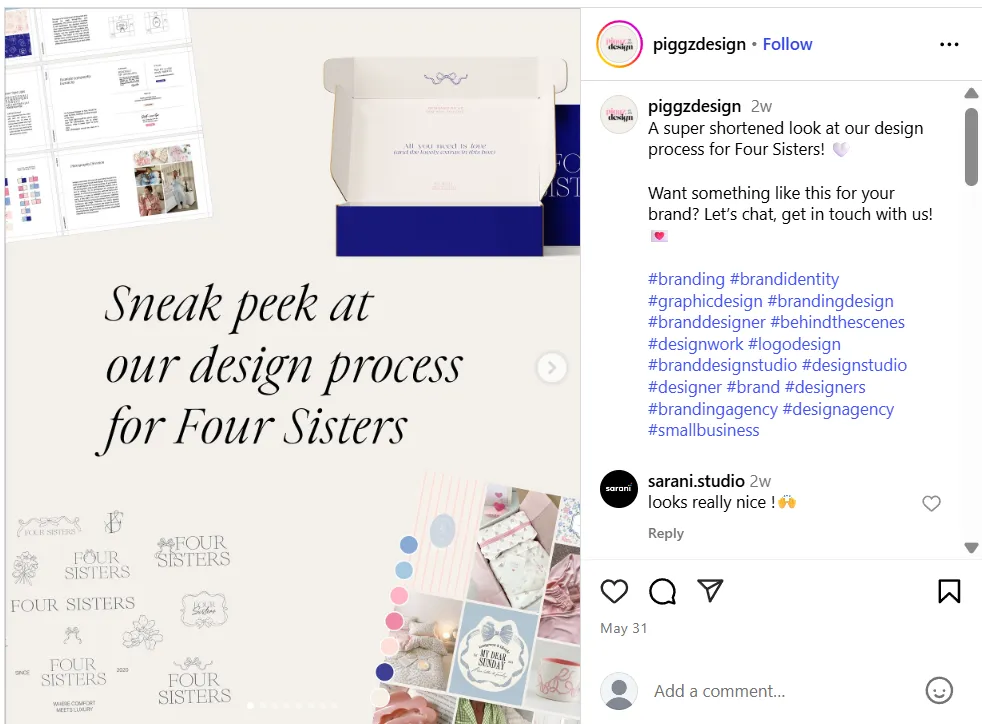
Tip: Use Reels and Carousels to highlight before-and-after projects, or share behind-the-scenes glimpses of your creative process.
LinkedIn – Land High-Ticket Clients and Collaborations
With over 67 million companies and 134.5 million daily active users, LinkedIn is an agency’s go-to platform for B2B networking and professional storytelling.
Here’s what agencies can do:
- Use LinkedIn to attract corporate clients and form strategic partnerships.
- Leverage it to establish authority in your design niche through professional content.
- Publish detailed case studies to showcase the process and results.
- Share thought leadership posts to position your agency as an industry expert.
- Use carousel-style mini portfolio slides to engage decision-makers like CMOs and Creative Directors.
The below LinkedIn post by IDEO is a strong example of how design agencies can lead with thought-provoking content. The visually striking graphic paired with insightful discussion points engages a professional audience, sparks dialogue, and helps elevate a brand’s authority.
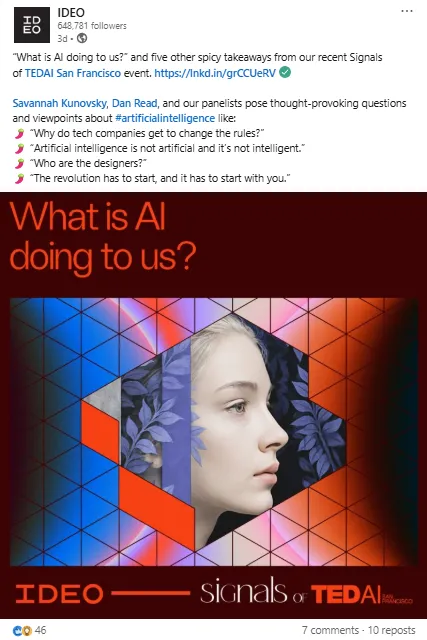
Pinterest – Drive Discovery and Website Traffic
Don’t underestimate Pinterest. It’s not just a place for DIY ideas, but a powerful visual search engine for agencies to attract potential clients. It helps you get discovered, especially by today’s trend-driven audience.
With 570 million monthly active users globally – and 96 million from the U.S. alone – it offers massive exposure potential.
Here’s how design agencies can use Pinterest:
- Share branding projects, mood boards, packaging ideas, and interior design work.
- Attracts users actively searching for creative inspiration.
- Perfect for longer shelf-life content that stays discoverable over time.
- Use Pins to link directly to your blog posts, case studies, or ecommerce design portfolios.
The below Pinterest graphic by JachOOs is a great example of how design agencies can use bold visuals and clear messaging to promote their services. It’s a smart blend of visual storytelling and conversion-focused design – ideal for brand visibility and lead generation.
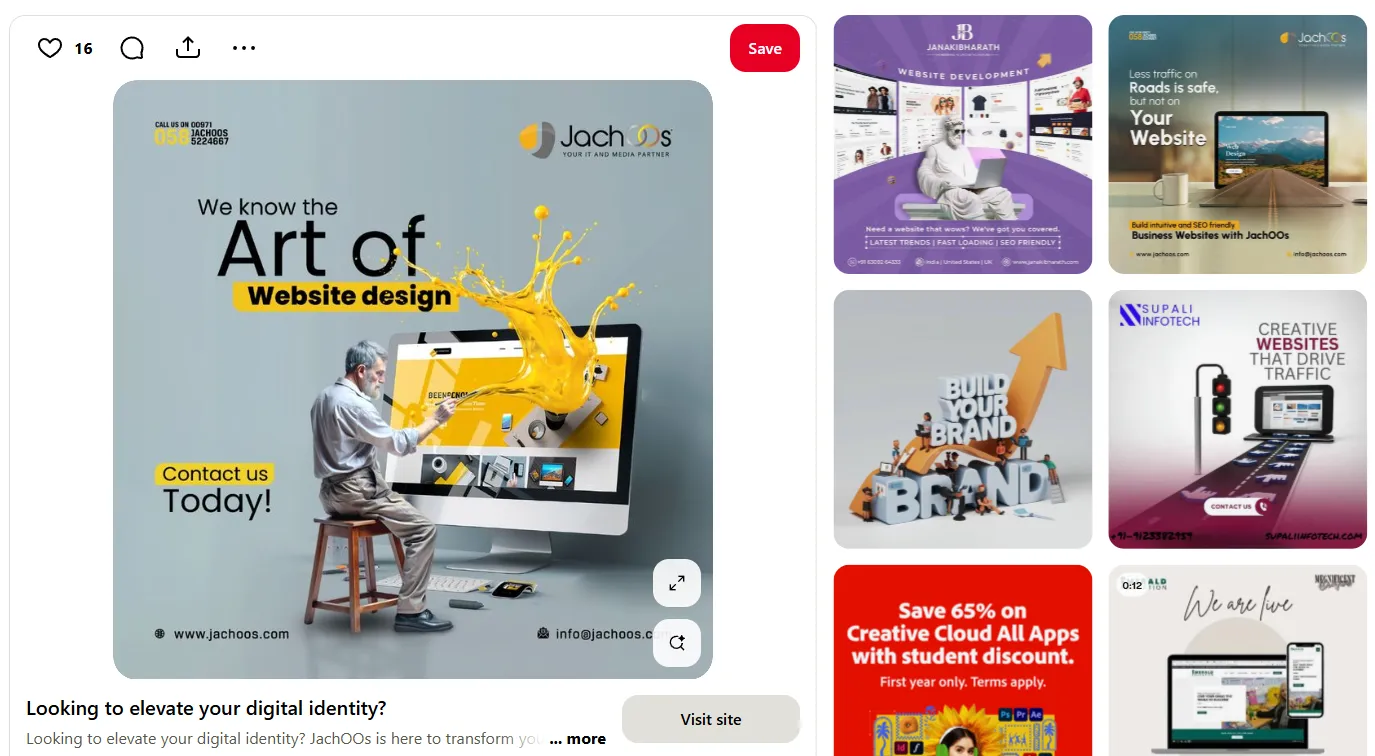
Behance & Dribbble – Build Authority in the Design Community
These two platforms are your design agency’s resume in action.
- Behance allows you to post in-depth case studies and full design narratives.
- Dribbble is great for quick visual hits, WIP (work in progress) shots, and staying connected with other creatives.
While they might not generate leads directly, they help you build credibility. Multiple clients check these platforms before reaching out to design agencies.
This Behance project by Higashi is a strong example of how design agencies can present UI/UX work in a structured, narrative-driven format. It showcases not just visuals, but the thinking behind the interface – from wireframes to final design.
This kind of in-depth case study builds credibility, reflects strategic process, and resonates with decision-makers seeking thoughtful design execution.
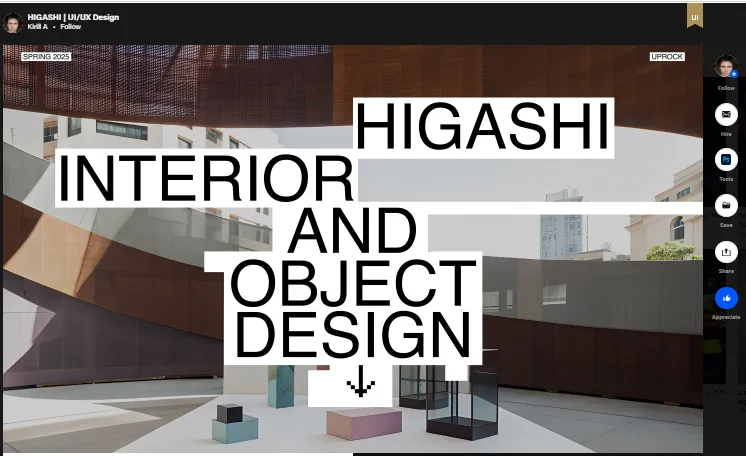
X/Twitter – Thought Leadership in 280 Characters
Sure, Twitter has its challenges – bot accounts, fleeting visibility, and fast content decay. But it still has a role to play.
27% to 35% of the US adults are on X/Twitter, 63.7% of them being male and 36.3% female.
Design agencies must use X to
- Comment on design trends, join real-time industry conversations, and share updates in a casual tone.
- Use it during industry events, launches, or when participating in social media campaigns.
The below Twitter post by DesignRush spotlights Outecho’s efficient 60-day product launch roadmap. With clear takeaways like lean sprints and built-in QA, it’s a strong example of how agencies can use X to share success stories and offer value-driven insights.
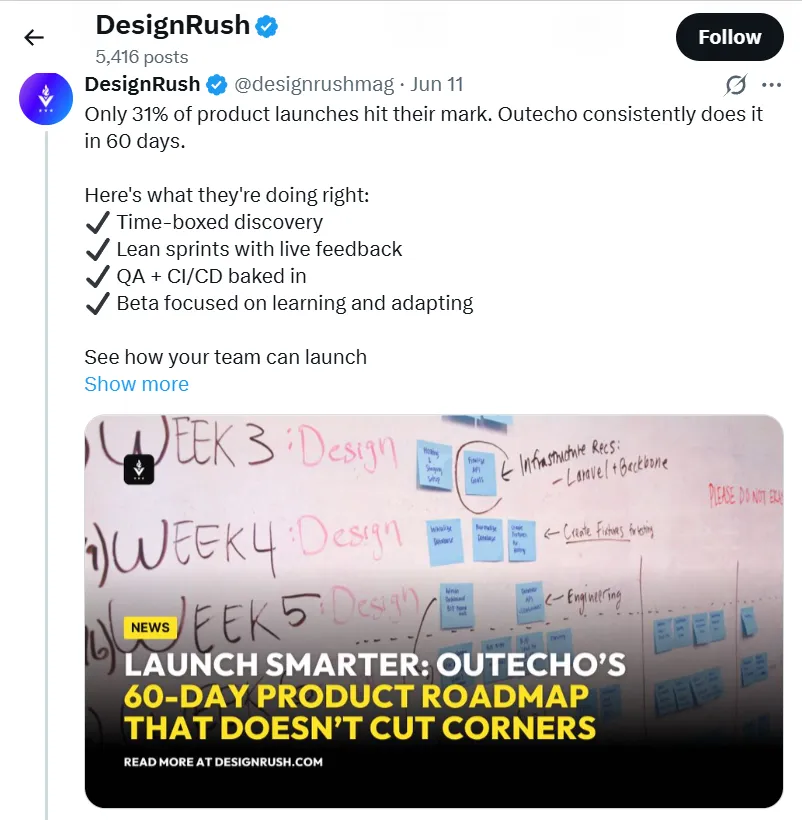
Start with any two/three of the above social media platforms, preferably Instagram and LinkedIn. This will help you reach both your dream clients and high-value collaborations without spreading your efforts too thin.
5. Creating a Content Calendar
Creativity without consistency can often lead to chaos. That’s why every design agency needs a well-planned content calendar and engaging social media content.
This helps keep your content purposeful, your posting consistent, and your brand voice steady across all platforms.
As a design agency, your visual game must also be equally strong. So, you need a calendar that pairs your creativity with content to create posts that not just look good but perform well.
Does your social media slip through the cracks when client deadlines pile up?
As a design agency, inconsistent posting can hurt visibility and weaken your visual brand presence.
That’s where SocialPilot’s Social Media Content Calendar comes in.
It lets you
- Visually map out your posts across platforms
- Align content with project timelines
- Keep your aesthetic sharp and consistent
All without scrambling at the very last minute.
Let us now understand how you can structure your content buckets while highlighting your best work:
Portfolio Highlights
Your past work is your strongest proof. Use your feed to showcase branding makeovers, packaging designs, logo evolutions, and web interfaces.
The below Instagram Reel showcases the portfolio of Bellman Agency, wherein they talk about some recent brands that they have worked with.
View this post on Instagram
Tip: Instead of just talking about the brand collaborations and past work, agencies must also talk about the problems they solved, their clients’ vision, and the transformation.
Behind-the-Scenes Process
Audiences love seeing real, uncut, and candid footage of what goes on behind the scenes.
Share snippets of your sketching phase, wireframes, moodboards, or brainstorming sessions. This builds trust and positions your agency as transparent, detail-oriented, and methodical.
The graphic below shows some snippets from day-to-day life at the Creative Brand Design agency. Such posts humanize your brand and build trust by showing clients the thought, care, and creativity behind your work that goes BTS.
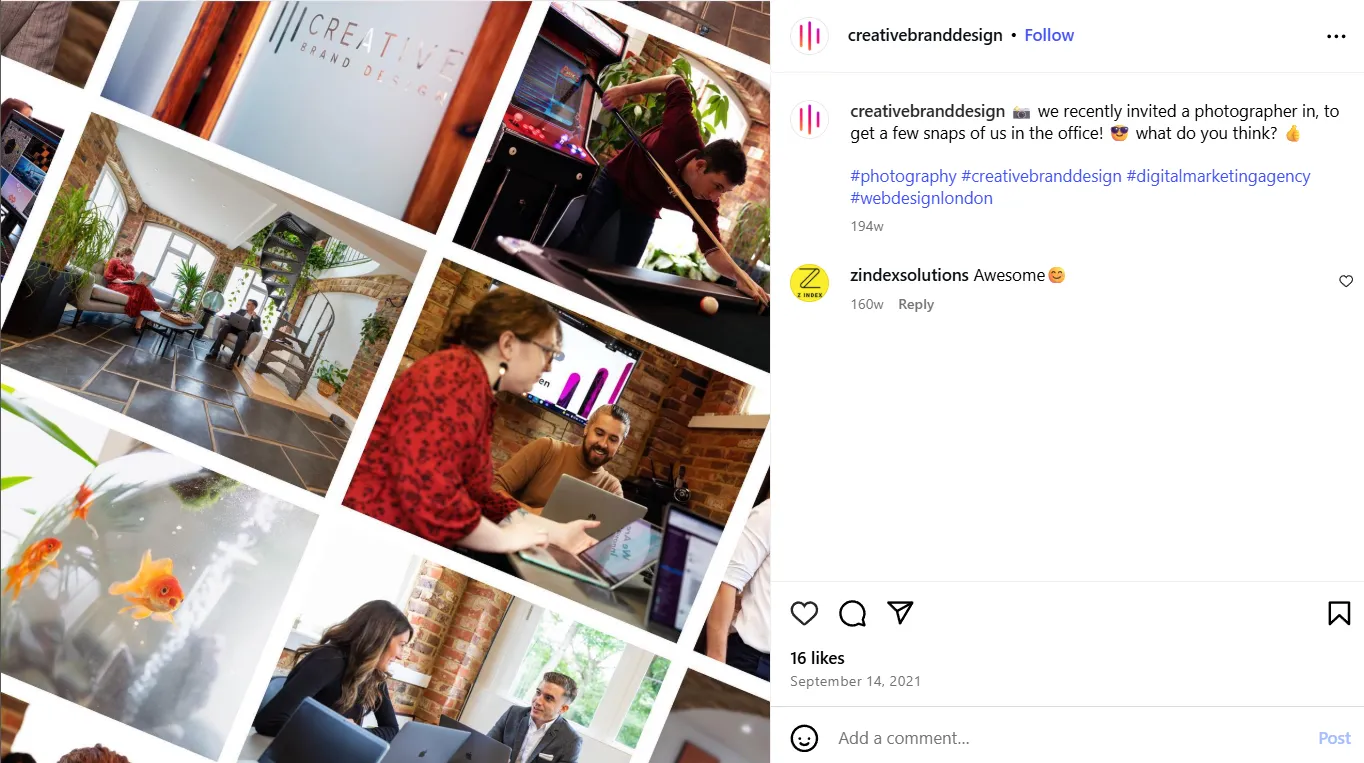
Design Tips & Thought Leadership
Establish authority by sharing quick design hacks, industry insights on visual trends, and branding dos and don’ts.
LinkedIn carousels, Twitter threads, or Instagram Reels are great formats here. You can also add stats or studies to strengthen your credibility.
The below reel by Picit Design offers some meaningful design tips. Such Reels position your agency as a helpful expert, which helps build authority & encourage engagement. It also keeps your agency top-of-mind when potential clients are ready to hire.
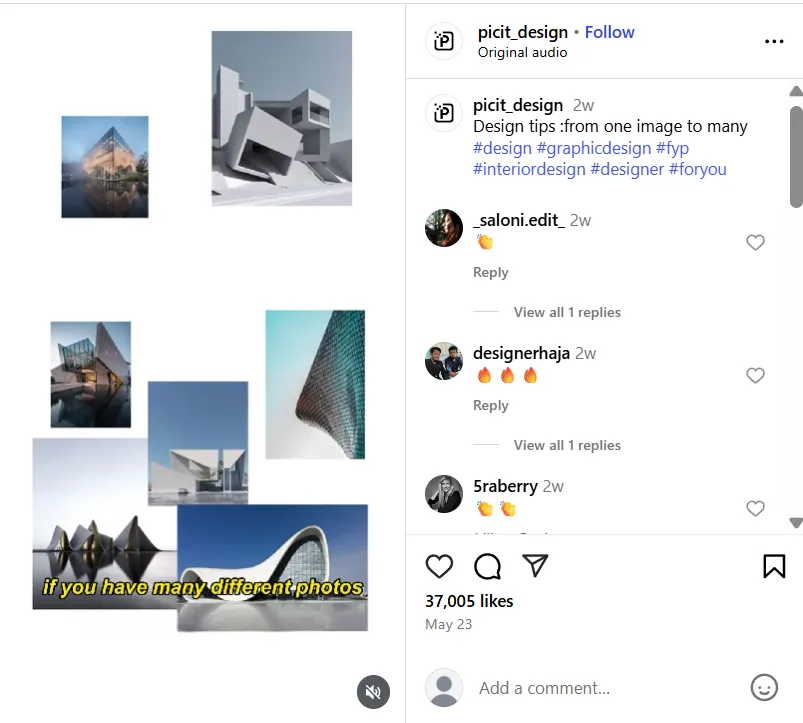
Client Testimonials & Case Studies
Social proof sells.
Repurpose written testimonials into quote cards, turn case studies into video testimonials, or create carousels showing measurable results. Create content that helps your potential client visualize working with you.
The image below is an Instagram post by a design agency – framingideas20. The post features direct praise from a satisfied client. This user-generated content serves as impactful social proof, significantly influencing potential customers in their decision-making process.
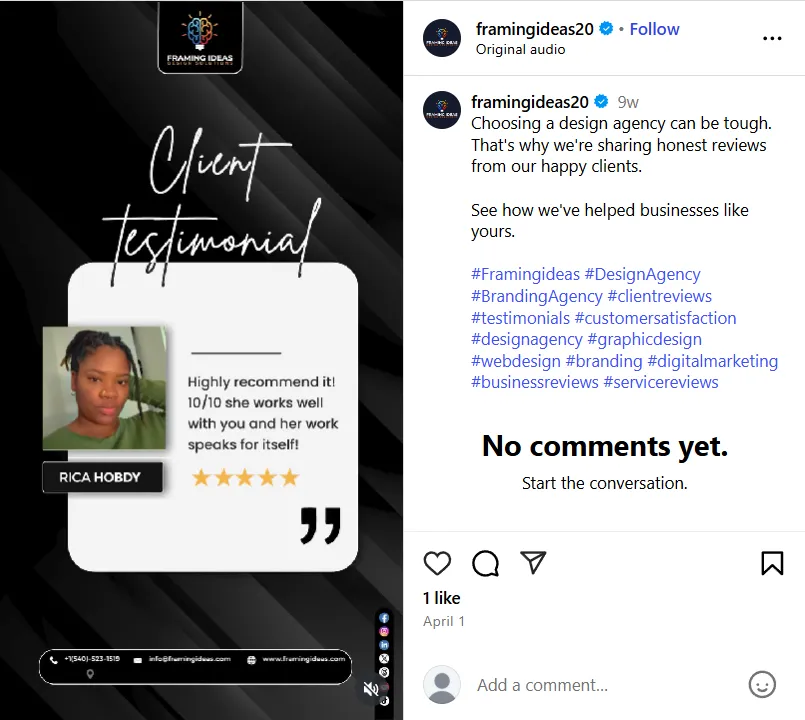
Newsletters on Social Media
While email is the traditional home for newsletters, repurposing and sharing your newsletter on the right social platforms can seriously expand its reach and boost engagement.
As a design agency, you can post your Newsletter on LinkedIn to connect with B2B audiences or share bite-sized newsletter takeaways as threads on Twitter.
This image shows a LinkedIn post featuring a newsletter by “Design for Business Growth.” Posting such insightful newsletters on LinkedIn can help design agencies establish their expertise in specific domains (e.g., UX in EdTech).
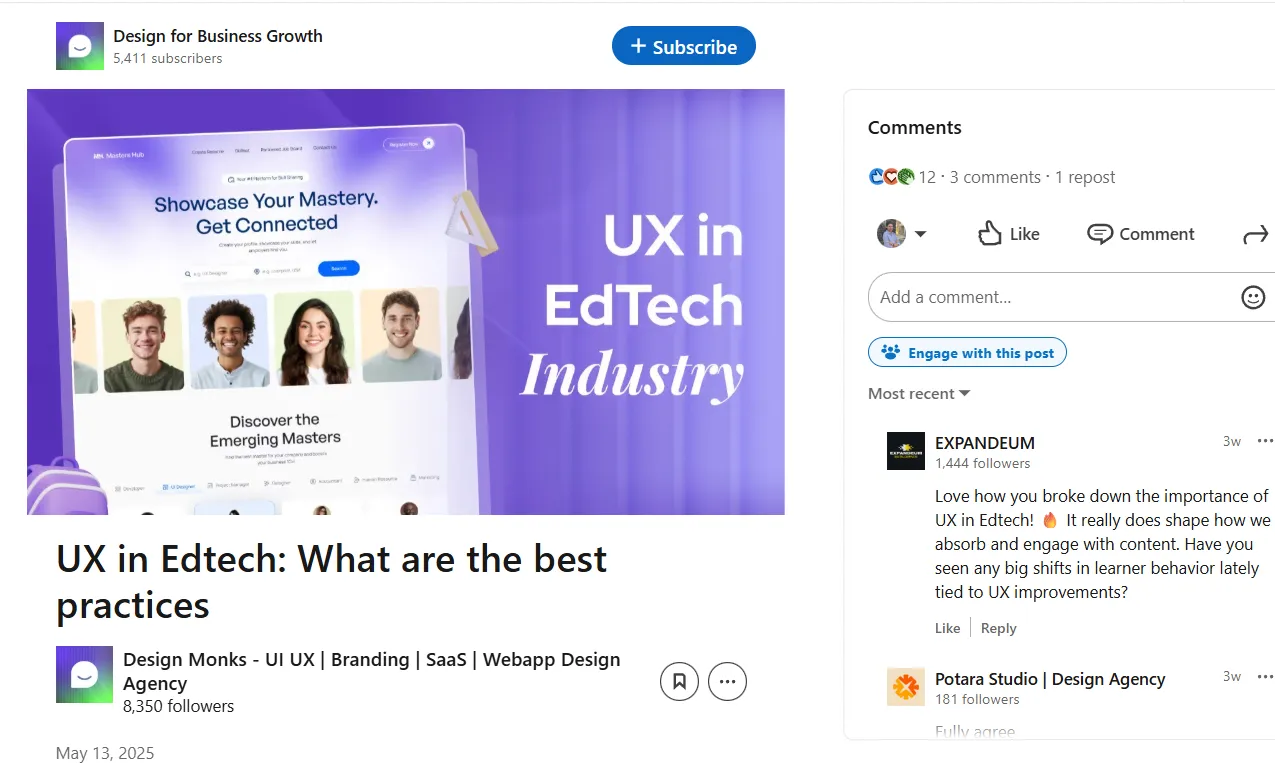
If you’re creating stunning content but still struggling to get seen, chances are you’re missing one (or more) of these three key ingredients: hashtags, algorithms, and timing.
When used together strategically, they can skyrocket your visibility and engagement without spending a dime on ads.
Let’s break them down:
Mastering Hashtags for Visibility
Hashtags aren’t just trendy add-ons – they’re your discovery tools.
Using the right hashtags helps your content land in front of people who are searching for what you offer.
Here’s how Neil Patel puts it:
“Tweets with hashtags get two times more clicks, retweets, favorites, and replies than tweets without hashtags.”
But hashtags are not just for Twitter; you also need to use them judiciously on platforms like Instagram, LinkedIn, TikTok, and YouTube Shorts.
Just make sure not to go overboard or pick random ones. Instead, use Instagram hashtags that focus on:
- Branded hashtags (like #StudioNameDesign) to build identity.
- Niche-specific hashtags (like #UXInspiration or #PackagingDesign) to connect with like-minded creatives.
- Location-based hashtags (like #NYCDesignAgency or #TorontoDesign) to target clients in your area.
Similarly, you must use hashtags on TikTok, too.
As per the SocialPilot’s TikTok Strategy Guide, wherein we have analyzed over 1.5 million TikTok accounts, posts with 1-5 hashtags have the highest reach rate at 1.16%.
Is your design agency still struggling to find the best-performing sets of hashtags?
Use SocialPilot’s Free AI Hashtag Generator to generate relevant and trending hashtags for your agency posts on Instagram, Facebook, TikTok, LinkedIn, and YouTube. This tool helps agencies with better discoverability and engagement.
Free AI Facebook Hashtag Generator
Supercharge your Facebook posts with the perfect hashtags using SocialPilot’s AI-powered Facebook Hashtag Generator.
Here is the Generated Result
Make sure to regularly test, analyze, and refresh your hashtag sets, and don’t forget to save and reuse your best-performing hashtags.
When to Post: Timing is (Almost) Everything
You’ve got the content and the hashtags. But, when’s the Best Time to Post on Social Media?
To understand the timing, you must first understand when your audience is most active.
Here are some optimal posting windows for a design agency:
- Midweek Mornings (Tues–Thurs, 10 AM–1 PM): Engagement peaks during working hours, when clients are scouting for inspiration or vendor ideas.
- Afternoon Spike at 3 PM (Mon–Fri): Design posts get the most traction during midday.
- Early Evenings (6–8 PM): As people unwind, they’re more likely to pause and absorb thoughtful carousels or Reels.
- Avoid Weekends (Sat–Sun): For B2B-oriented content, Mondays–Fridays are consistently stronger across LinkedIn, Instagram, and Pinterest.
These are the times when your audience – creative directors, startup founders, marketing leads – typically scroll through their social media feeds for design inspirations.
7. Engage
Social media isn’t a one-way street. It’s a conversation.
As a design agency, you must jump into the conversations that matter to your audience. Whether it’s sharing your take in a Facebook design group, offering advice in a Twitter thread, or commenting in niche Instagram communities, showing up is key.
If you want meaningful engagement, you’ve got to be an active participant, not just a passive poster.
For example, If you are a design agency, looking to engage on Twitter, here are some threads you can engage with:
- UI/UX Teardowns & Design Reviews – show your expertise and subtly share your work.
- Design Tool Announcements (Figma, Adobe, etc.) – Join product discussions or comment on new features with use-case examples.
- Branding Trend Discussions – Threads about color palettes, logo refreshes, typography debates – offer your process or client-friendly analogy.
- Freelancer or Founder Q&A Threads – Founders often ask for recommendations or insights; respond like a consultant, not a salesperson.
Additionally, you can also use visuals or branded images to stand out in such threads. Just remember to share honest insights and experiences, and refrain from overselling.
8. Deep Dive Into the Metrics
Key metrics like likes, views, and follower growth might look great at first glance, but real social media success for design agencies lies beneath the surface.
To truly understand how your content is performing, you need to zoom in on metrics that reveal intent, influence, and impact.
Here are some key metrics that matter to design agencies:
- Portfolio Performance: Which visuals led to profile visits or click-throughs to your “Work” page?
- BTS Content Engagement: Are behind-the-scenes posts sparking DMs or bookmarks? These often reflect genuine interest from founders or CMOs looking for a capable team.
- Lead Form Completions: How many inquiries did that client testimonial carousel generate?
- Revenue Attribution: Can you trace a project inquiry back to a specific post, campaign, or platform?
The real magic happens when you link your content to conversions. With proper tracking in place, you can uncover
- Where your best leads came from (Instagram, LinkedIn, etc.).
- Which post types pushed prospects through the funnel?
- How much revenue do all social channels actually drive?
A thoughtful deep dive into your key metrics doesn’t just tell you what worked – it tells you what to do next. That’s how you create content that is smart and helps you scale.
We know tracking analytics for different social platforms can be difficult and time-consuming.
But with SocialPilot Analytics, you can now create a detailed analytics report for your design agency.
Simply pull social media insights for different platforms like Instagram, Facebook, LinkedIn, Twitter, etc, and create clean visual reports which you can share with your team or clients.
From likes and shares to profile visits and lead generation, these reports can offer agencies a sneak peek into their social media performance.
Watch this video to learn more
8. Refining the strategy
Now it’s time to transform valuable insights into action.
Refining the social media marketing plan across multiple channels is all about understanding what’s working and fixing what’s not.
Here’s how design agencies can refine their digital marketing strategy:
- Optimize Visual Content Based on Engagement
Are your carousels getting more saves than Reels? Are mockups driving DMs while moodboards aren’t? Double down on what sparks real interest. - Refine Posting Schedules by Platform
Are founders engaging with your posts on LinkedIn around 10 AM, while Instagram Reels gain traction at night? Adjust your posting rhythm based on audience behavior. - Rework Visual Aesthetics
Test new presentation styles; flat lay mockups vs. live context use, muted tones vs. bold palettes, mobile-optimized formats vs. full-screen experiences. - Adjust Hashtags and Targeting Per Platform
Your niche might respond to #BrandIdentityDesign on Instagram, but search for “creative agency in Florida” on LinkedIn. Refine accordingly. - A/B Test Captions and CTAs
Try testing two versions of your case study caption: one with a question, one with a results-driven hook (e.g., “Brand refresh that boosted conversions by 31%”).
It’s not just about sticking with what worked last month – it’s about staying agile, experimenting with intent, and making data-driven strategies.
IDEO (pronounced “EYE-dee-oh”) isn’t just a design agency, it’s a movement. With 648K+ followers on LinkedIn, 230K on Instagram, and over 329K on X, IDEO has become the gold standard for what it looks like when creativity meets clarity and scale.
But this success didn’t happen overnight. So, what’s the blueprint behind IDEO’s social media presence? Let’s decode the strategy that made them not just follow-worthy, but follow-inspiring.
The Origin Story:
IDEO is a design consultancy launched in 1991 with a mission that felt radically simple: design for humans, not just products. Their goal was to craft human-centered designs and experiences rooted in empathy.
But they didn’t just stop at good ideas. They systemized design thinking, built a cross-disciplinary team of designers, engineers, and behavioral scientists, and scaled their creative process like no one else.
Challenges they faced:
- Competing in a saturated market of design-first agencies.
- Scaling from bespoke projects to impact-driven enterprise solutions.
- Staying relevant while their own methodology became mainstream
1. Understanding People and Creating Solutions
IDEO didn’t just guess what users wanted; they studied them. Their process revolved around deeply understanding the needs, behaviors, pain points, and motivations of real people.
They brought together designers, engineers, and psychologists to unpack problems, challenge assumptions, and prototype solutions that actually make sense to users.
The post below reflects their ideology of #HumanCenteredDesign and talks about how their design process is primarily focused on working for and with people.
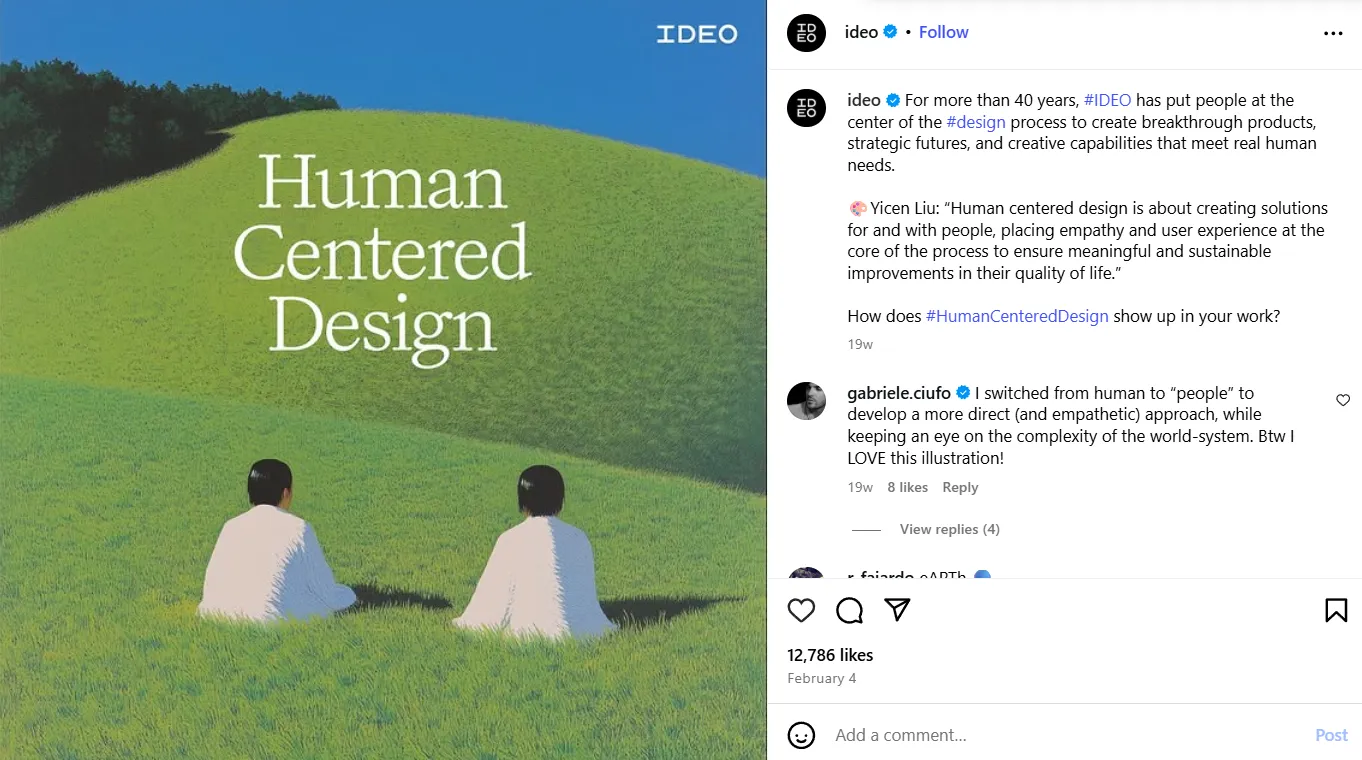
2. They Sparked Conversations.
IDEO uses its social network to ask better questions, not just share polished answers.
From thoughtful prompts to behind-the-scenes research insights, every post nudges followers to think, reflect, and engage. It’s not broadcasting; it’s dialogue.
In the post below, IDEO sparks a meaningful conversation about how dating could be more intentional. The post ends with a thoughtful question: “What innovations in relationships would you like to see in the future?”
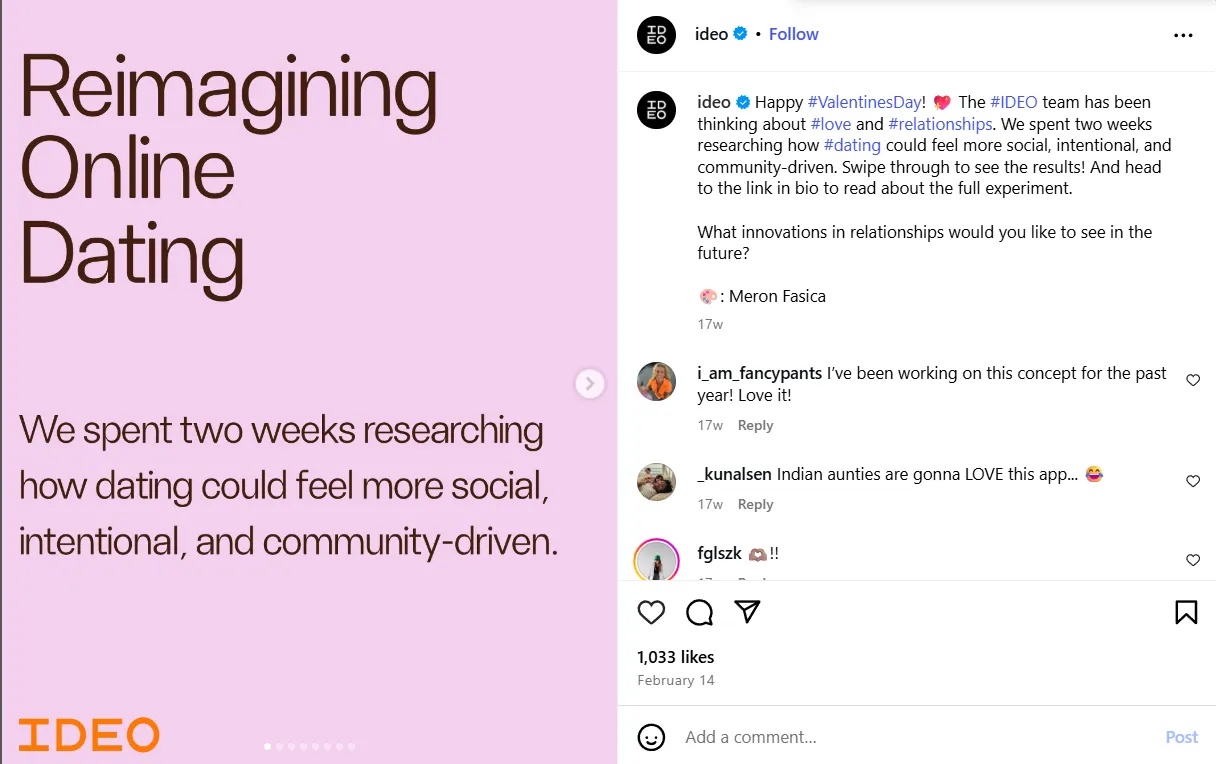
3. They Simplified the Complex.
They broke down complex design thinking, so it’s easy to grasp.
Using infographics, short videos, carousels, and plain-speak storytelling, they make abstract concepts actionable and relatable.
The below post talks about their course “Innovating with Data,” which aims to unearth deeper insights into finding and using the right kind of data.
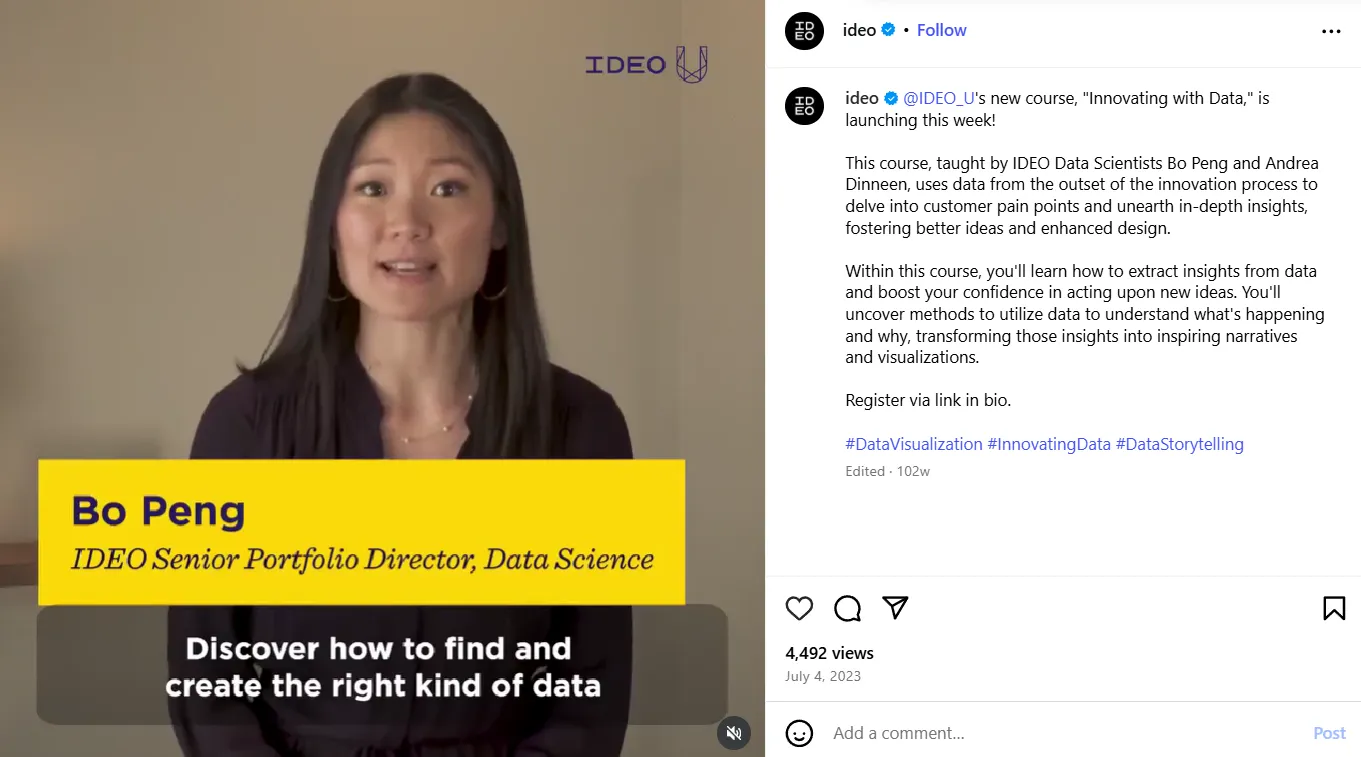
Alt text: Breaking down complex topics
4. They Focused on Impact, Not Just Aesthetics.
Instead of just showcasing stunning visuals, IDEO highlighted why the design matters.
You’ll see real-world use cases, stories of transformation, and reflections on how their work deeply solves human problems.
IDEO partnered with Heartstream to design a user-friendly medical device, as shown in the image below, that’s both cost-effective and easy to transport, making life-saving technology more accessible and practical.
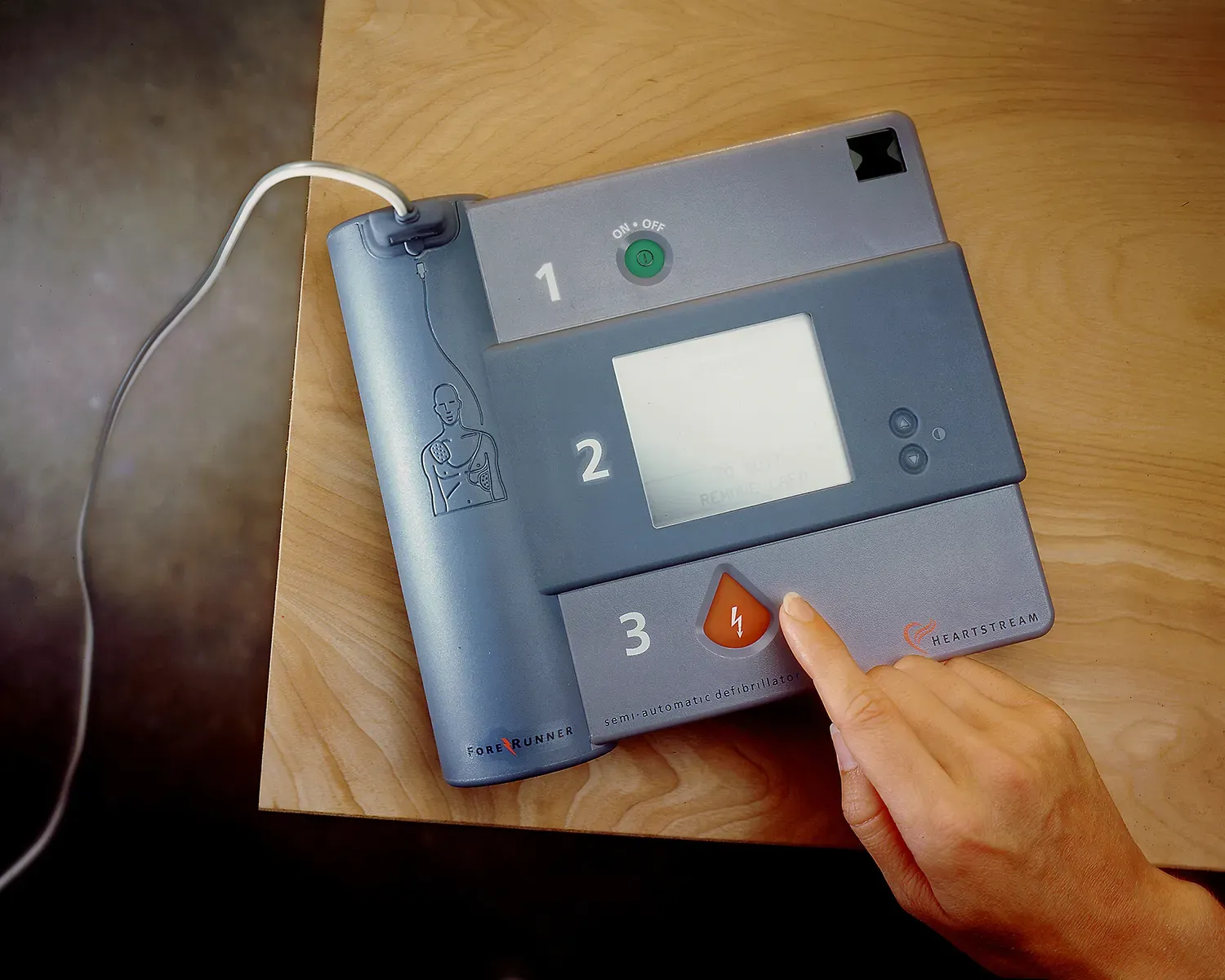
5. They Humanized the Brand.
IDEO frequently features its team – designers, strategists, researchers – showcasing diverse voices and collaborative thinking.
It’s not “here’s what we built,” it’s “here’s how we think, and here’s who helped us get there.”
6. They played to each platform’s strength.
- LinkedIn: Long-form articles, research breakdowns, and innovation leadership
- Instagram: Visual storytelling, inspirational quotes, project snapshots
- X (Twitter): Quick takes on trends, real-time updates, commentary
- YouTube: In-depth discussions, educational series, and creative case studies
They didn’t repurpose blindly; they optimized natively.
7. They Showed the Mess, Not Just the Masterpiece.
From project failures to uncomfortable lessons, IDEO shares the whole journey. That authenticity helps them build trust and makes them relatable, even aspirational.
For instance, the below post by IDEO addresses the chaotic state of the news industry and raises uncomfortable but necessary questions about trust, misinformation, and the role of technology.
This post also demonstrates that meaningful innovation starts with acknowledging what’s broken and taking measures to fix it.
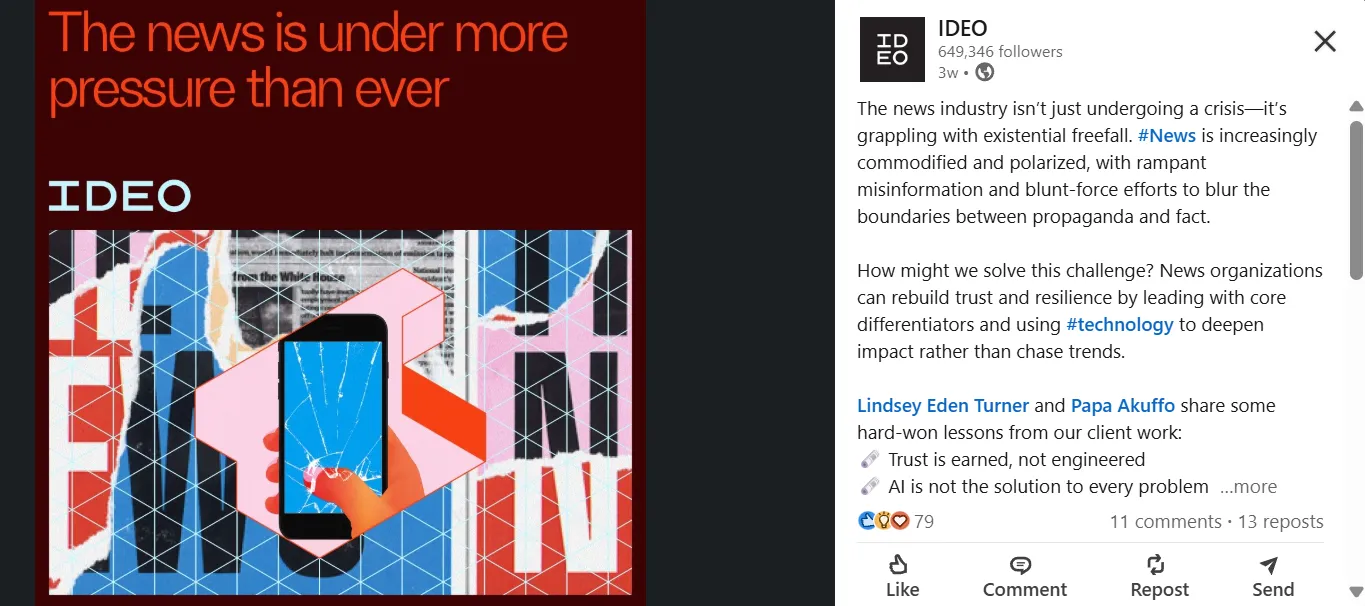
Final Thoughts
As a design agency, your job is more than just showcasing your design.
You must position yourself as a trusted authority across social media platforms to attract high-ticket clients and drive measurable business growth.
And it all starts with understanding your audience and posting the right content on the right platforms at the right time.
But again, it’s not just about posting anything that comes to your mind. It is about posting compelling content at peak times, when your audience is most active.
This is where SocialPilot can make things easy. It helps you create posts, schedule content, and even suggest the right times to post. Additionally, it provides you with post analytics to help you understand what’s working.
Let SocialPilot take some of the burden off your shoulders. Try it for yourself and experience the difference.




